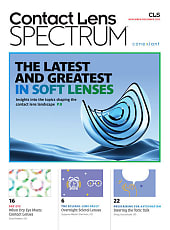As we go to press, the Tear Film & Ocular Surface Society has released the Dry Eye Workshop (DEWS) III. Its predecessor, DEWS II, was released 8 years ago. So how does
DEWS III differ from the last report? Below are some highlights, but, first, this caveat:
“To get the most out of DEWS III, clinicians are going to need to read it in its entirety,” stresses
Lyndon Jones, lead author of the “TFOS DEWS III Management and Therapy Report” and professor; School of Optometry & Vision Science, University of Waterloo, Ontario, Canada. “And I think they’ll find it’s well worth their time.”
Now, for the highlights:

Revised Definition
DEWS III contains a new definition of dry eye. Specifically, the new definition is, “a multifactorial, symptomatic disease characterized by a loss of homeostasis of the tear film and/or ocular surface, in which tear film instability and hyperosmolarity, ocular surface inflammation and damage, and neurosensory abnormalities are etiological factors.”
“The definition has been revised to acknowledge that the loss of homeostasis can occur in the ocular surface as well as in the tear film,” explains James S. Wolffsohn, lead author of the “TFOS DEWS III Diagnostic Methodology” section and dean of both the School of Optometry and the Department of Audiology at Aston University, in Birmingham, England.
One Questionnaire
The DEWS III authors came to the consensus that one “comprehensive, standardized” questionnaire should be used that establishes the symptomatic element of the disease. That questionnaire is the Ocular Surface Disease Index-6.
“The OSDI-6 removes the variability of establishing the necessary symptoms that is caused by allowing multiple alternative questionnaires, while maintaining the same symptom level assessment,” Wolffsohn points out.
Subtyping
While both DEWS I and DEWS II contained the dry eye subclassifications of aqueous deficient, evaporative, or a combination, DEWS III expands the identification of etiologic drivers to 9, within 3 subcategories: the tear film, the eyelids, and the ocular surface. What’s more, the prescribing algorithm has been updated accordingly due to the “explosion” of proven treatments for these subtypes since the release of DEWS II, points out Dr. Jones.
“We have basically summarized for the clinician the routes that they can go to best manage the patient’s DED based upon all the root causes of their DED,” he explains.
To access DEWS III, visit https://www.sciencedi rect.com/special-issue/10PHL822N4T. OM



